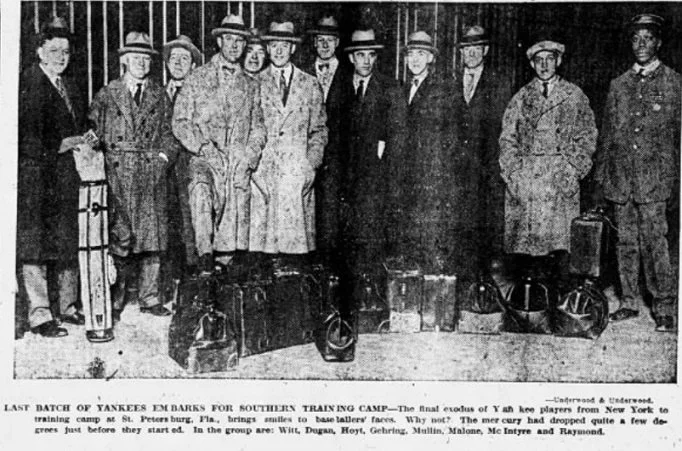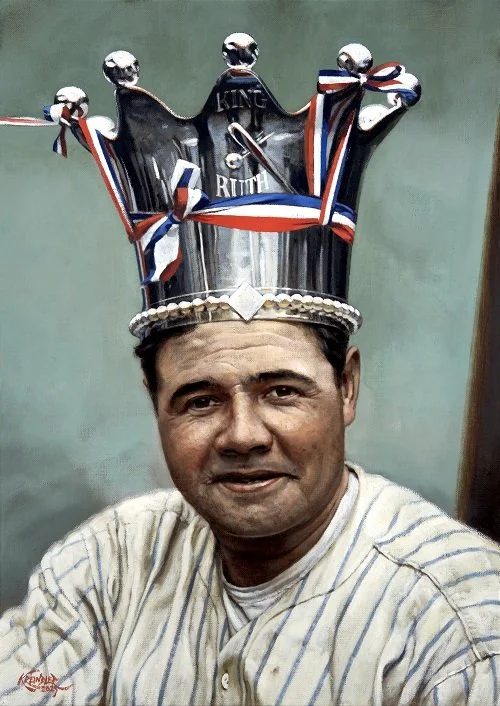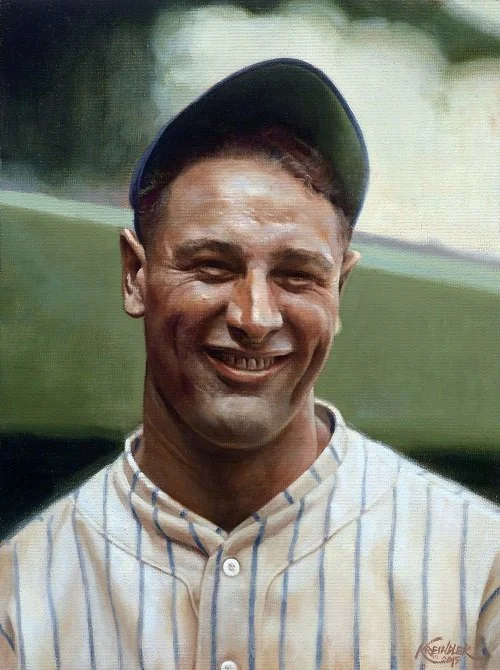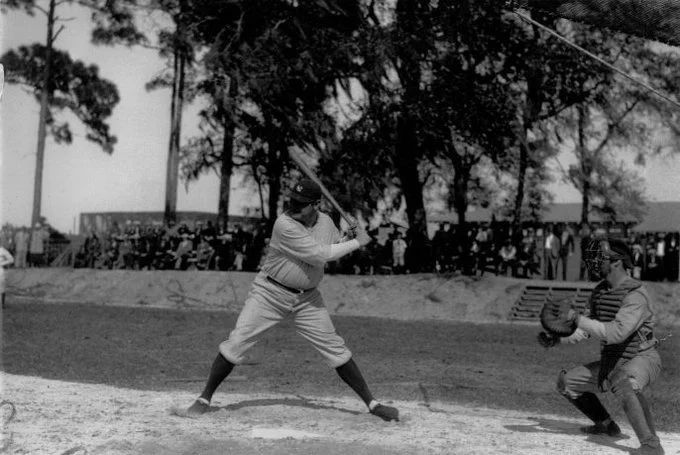The Once and Never Yankee
Bibbs Raymond
Isn’t the start of the baseball season grand?
That wasn’t the case 100 years ago when Doherty Silk Sox star right fielder Bibbs Raymond attempted to leave semipro ball to play in the major leagues … alligators be damned.
New York Yankees head scout Paul Krichell had signed Raymond for $1,500 during the summer of 1924 but earning a spot with the 1925 team would be difficult. New York had an established outfield of the great Babe Ruth, slugger Bob Meusel, future Hall of Famer Earle Combs, and veterans Ben Paschal, Whitey Witt and Bobby Veach.
From The Brooklyn Eagle: Bibbes Raymond second from right; Lou Gehrig center rear with bow tie.
Bibbs, then 26, didn’t see it that way. He’d played against major leaguers since he was 17 in Sunday exhibition games with the Silk Sox. Outside of Ruth (whom Bibbs considered a great player but a “blowhard”), he was confident that he was the equal of any outfielder.
After a long train trip from New York City, Raymond headed to Crescent Lake Park for spring training.
Paterson, N.J., businessman and Silk Sox fan Frank McLaughlin was vacationing in St. Petersburg and watched the Yankees veterans ignore rookies like Raymond. Shagging flies in the outfield, they’d call off the young players to make the catch and then toss the ball to one of them to throw it back to the infield.
“King Ruth”; artwork by Graig Kreindler
“I never saw such discouraging conditions as I encountered in the Yankees camp,” McLaughlin told the Paterson Evening News. “Fellows like Babe Ruth, who should know better, give the recruits the cold shoulder and pass them by …” He added: “What encouragement is there for a youngster trying to break through? None whatever.”
“The Starter” (Lou Gehrig); artwork by Graig Kreindler
Raymond’s only reported playing time came in a game between the Yankees “Recruits” versus the “Regulars.” The Recruits won, 10-3, knocking around hurlers Waite Hoyt and Sam Jones.
The Brooklyn Daily Eagle wrote: “The victory was largely due to the hitting of Columbia Lou Gehrig, Tommy Mullen, the diminutive Brooklyn semi-pro star, and Al (Bibbs) Raymond, formerly of the Paterson Silk Sox.”
Besides beating the veterans, the rookies’ biggest excitement, the New York Daily News reported, was when Bibb’s fellow recruit Nick Cullop “pursued a hard-hit ball through the palmetto fringe around the outfield and into a shallow pond. A six-foot alligator clicked its teeth and leered at the young and tender player.”
The Bambino in a 1925 spring training game.
Stuck on the bench, Bibbs was seething. The hell with the veterans and alligators – he’d come to Florida to play. Two weeks into spring training, Raymond made a long distance call to Clifton, N.J., and Harry Doherty, owner of the Doherty silk mill. “Bibbs called my father,” said son Paul Doherty. “He said, ‘Mr. Doherty, they won’t let me play!’”
By March 23, Raymond’s big league ordeal was over. The Yankees ordered him home to await a minor league assignment. Bibbs wanted to play at either Newark or Jersey City, near his wife Sylvia and their children; the Yankees said they’d contact him.
When word arrived, Raymond was assigned to play for the New Haven Profs of the single A Eastern League. Bibbs took the train to Connecticut, spoke with manager Neal Ball, looked around at the town … and hightailed it back to New Jersey. He was forever done with organized ball.
“The Might Manager” (Miller Huggins) artwork by Graig Kreindler
But quitting the Yankees wasn’t simple since Raymond had received a signing bonus. Daughter Kathleen (Raymond) Lillo remembered the diminutive Yankees manager Miller Huggins coming to their home to try and talk her dad into returning to New Haven.
“As my father kept refusing,” Lillo said, “Huggins got angrier and angrier. He finally rocked himself out of the no-back rocking chair he was sitting in and onto the floor.”
Silk Sox team owner Harry Doherty ultimately bought back Raymond’s Yankees contract returning him to the Silk Sox. Raymond later told sportswriter Joe Gooter: “I was homesick all the time. In those days, a player starting out in the big leagues would be paid somewhere between $3,000 and $3,500 a year. I couldn’t see it, because I was making $200 a week just playing semi-pro ball. I was getting $50 a game from the Silk Sox and there would be one game away and the Sunday game at home. Then I played at Norristown, Pa., and some twilight ball with different teams during the week.
“Besides, I was holding down a weaver’s job at the Doherty mill. So I figured, what’s the sense of playing big league ball, especially if I had to go to New Haven first?”
Could Bibbs Raymond have ultimately succeeded in the big leagues?
Jesse “Mountain” Hubbard
Eddie Mayo
It’s likely. Negro League pitcher Jess “Mountain” Hubbard always considered Raymond the toughest Silk Sox hitter to face. Clifton’s Eddie Mayo, who played nine major league seasons (finishing second in the 1945 AL MVP race), said, “Bibbs was all-star caliber – a lot of talent and a lot of power for a little man (Raymond was 5’6”, 145 lbs.)” Stan Baumgartner, Bibb’s Silk Sox teammate and a major league pitcher with the Philadelphia A’s and Phillies, told the Paterson Evening News that Raymond was one of the best ballhawks he ever saw. And Paddy Smith, a semipro star and briefly a major leaguer with the Boston Red Sox, agreed, telling the newspaper, “Bibbs Raymond was good enough to have played with any team in major league baseball.”
Years later on April 30, 1967, the city of Clifton celebrated “Clifton Day” at Yankee Stadium and the former Silk Sox players were invited. Bibbs, now 69, sat with Clifton’s mayor in box seats near the field, and watched his favorite player Mickey Mantle hit a walk-off homer to win the first game for the Yankees, 4-1.
It’s easy to imagine Raymond wistfully gazing out on the field … wondering what life might have been like had he played at New Haven the way Miller Huggins wanted.
Instead, he remained the once and never Yankee – a hometown hero who never left.
Special thanks to Graig Kreindler, “The Painter of the National Pastime,” for his art with this article.








